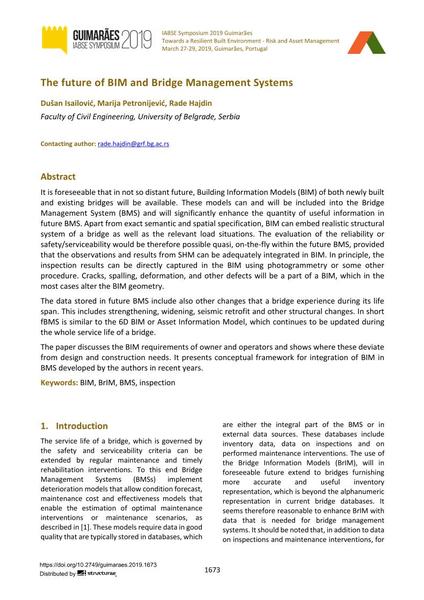The future of BIM and Bridge Management Systems

|
|
|||||||||||
Bibliographic Details
| Author(s): |
Dušan Isailović
(Faculty of Civil Engineering, University of Belgrade, Serbia)
Marija Petronijević (Faculty of Civil Engineering, University of Belgrade, Serbia) Rade Hajdin |
||||
|---|---|---|---|---|---|
| Medium: | conference paper | ||||
| Language(s): | English | ||||
| Conference: | IABSE Symposium: Towards a Resilient Built Environment Risk and Asset Management, Guimarães, Portugal, 27-29 March 2019 | ||||
| Published in: | IABSE Symposium Guimarães 2019 | ||||
|
|||||
| Page(s): | 1673-1680 | ||||
| Total no. of pages: | 8 | ||||
| DOI: | 10.2749/guimaraes.2019.1673 | ||||
| Abstract: |
It is foreseeable that in not so distant future, Building Information Models (BIM) of both newly built and existing bridges will be available. These models can and will be included into the Bridge Management System (BMS) and will significantly enhance the quantity of useful information in future BMS. Apart from exact semantic and spatial specification, BIM can embed realistic structural system of a bridge as well as the relevant load situations. The evaluation of the reliability or safety/serviceability would be therefore possible quasi, on-the-fly within the future BMS, provided that the observations and results from SHM can be adequately integrated in BIM. In principle, the inspection results can be directly captured in the BIM using photogrammetry or some other procedure. Cracks, spalling, deformation, and other defects will be a part of a BIM, which in the most cases alter the BIM geometry. The data stored in future BMS include also other changes that a bridge experience during its life span. This includes strengthening, widening, seismic retrofit and other structural changes. In short fBMS is similar to the 6D BIM or Asset Information Model, which continues to be updated during the whole service life of a bridge. The paper discusses the BIM requirements of owner and operators and shows where these deviate from design and construction needs. It presents conceptual framework for integration of BIM in BMS developed by the authors in recent years. |
||||
| Keywords: |
inspection BIM BMS BrIM
|
||||
